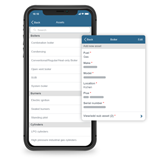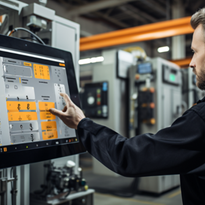Industrial touch screen monitors play a crucial role in modern manufacturing, process control, and automation environments. These intuitive interfaces streamline operations, enhance productivity, and improve overall efficiency. However, to ensure optimal performance and longevity, regular maintenance and proactive troubleshooting are essential.
In this comprehensive guide, we delve into the key aspects of maintaining and troubleshooting industrial touch screen monitors. From routine cleaning and calibration to addressing hardware and software issues, we explore best practices and tips to keep touch screen monitors operating at their best.
1. Regular Cleaning and Maintenance: Ensuring Longevity and Performance:
Regular cleaning and maintenance are vital for industrial touch screen monitors to ensure their longevity and optimal performance.
Dust and dirt accumulation can hinder touch sensitivity and screen visibility, impacting user interactions and potentially causing calibration issues. By keeping the touch screen surface clean, operators can maintain precise control and prevent misinterpretations of touch inputs.
Regular maintenance also extends the lifespan of components, reduces the risk of premature failure, and minimizes downtime. Following manufacturer recommendations for cleaning and maintenance ensures that touch screens are cared for appropriately and supports a hygienic environment, particularly in industries where cleanliness is critical.
Prioritizing regular cleaning and maintenance enhances productivity, reliability, and overall user experience, contributing to seamless and efficient operations in industrial settings.
Key points to consider include:
- Cleaning Solutions and Materials
Using approved cleaning solutions and soft, lint-free cloths is crucial for maintaining the integrity of the touch screen's sensitive surface. The touch screen surface is designed to be responsive to touch inputs, and using the wrong cleaning solutions or abrasive materials can lead to scratches or damage, ultimately affecting touch sensitivity and overall functionality. When selecting cleaning solutions, it is essential to use those specifically recommended by the touch screen manufacturer or those explicitly designed for touch screens. Avoiding harsh chemicals and abrasive materials is essential to ensure that the screen's protective coatings and sensors remain intact.
- Scheduled Cleaning Routine
Implementing a regular cleaning schedule is a proactive approach to maintain the touch screen's performance and appearance. Depending on the industrial environment's cleanliness and usage, the cleaning frequency may vary, but it is essential to establish a consistent routine. Daily or weekly cleaning can be suitable for high-traffic environments, while less frequent cleaning may suffice for less demanding settings.
- Cleaning Around Sealed Edges
When cleaning industrial touch screens, particular attention should be paid to the areas around sealed edges. These edges protect the internal components from liquid ingress and potential damage. While it is essential to maintain the entire touch screen surface, cleaning around the edges requires caution to prevent liquid seepage into the internal components. Using excessive cleaning solutions or allowing liquids to seep into the seams can lead to malfunctioning touch screens and even corrosion of internal circuitry.
- Proper Handling and Storage
for preventing accidental damage. Industrial touch screens can be subjected to various stresses during operation, including impacts, pressure, and exposure to extreme temperatures. Operators should be trained to interact with the touch screen gently and avoid using excessive force during touch interactions. Additionally, proper storage practices are crucial when the touch screen is not in use. Storing the touch screen in a clean and dry environment, away from direct sunlight and extreme temperatures, helps prevent damage caused by environmental factors.
2. Addressing Dust and Liquid Ingress: Preventing Screen Damage:
Dust and liquid ingress are two common challenges that industrial touch screen monitors face, and their presence can significantly compromise the functionality and performance of these essential devices. In industrial environments where dust, dirt, and liquids are prevalent, it is crucial to understand how these elements can impact touch screen monitors:
In industrial settings, dust and dirt particles are constantly circulating in the air, and they can easily settle on the touch screen surface. Over time, the accumulation of dust and dirt can create a thin layer on the screen, which may not be immediately noticeable but can gradually affect touch sensitivity. When operators interact with the touch screen, the accumulated particles can interfere with the capacitive or resistive touch technology, leading to inaccuracies in touch inputs. As a result, users may experience delayed responses, missed touches, or incorrect commands, hindering their ability to navigate through applications or control industrial processes effectively.
Dust and dirt particles can create a barrier between the user's finger and the touch screen's surface, affecting touch sensitivity and responsiveness. When the touch screen surface becomes contaminated, it requires more pressure from the operator's finger to register a touch input. This phenomenon is often referred to as "false touch" or "touch lag." The reduced touch sensitivity can frustrate operators, as they need to apply excessive force to achieve the desired touch response, leading to fatigue and reduced productivity.
Dust and dirt accumulation on the touch screen surface can obscure the display's visibility, diminishing the quality of information displayed. The build-up of particles can create a hazy or cloudy appearance, making it difficult for operators to read critical data, control settings, or execute tasks accurately. Reduced display visibility not only hampers operational efficiency but also poses safety risks in industries where quick and precise decisions are vital
Ideally, dust and liquid ingress are significant challenges that can compromise the functionality, accuracy, and reliability of industrial touchscreen monitors. By regularly cleaning and maintaining touch screen surfaces, implementing proper sealing measures, and following best practices for touch screen usage and environmental control, industrial facilities can mitigate the detrimental effects of dust and liquid ingress, ensuring smooth and uninterrupted touchscreen performance in critical industrial operations.
Key considerations for protecting screens from dust include the following:
- Enclosures and Sealing: Using touch screen enclosures with proper sealing to protect against dust, moisture, and other contaminants.
- Industrial-Grade Touch Screens: Opting for industrial-grade touch screen monitors designed to withstand harsh environmental conditions.
- Regular Inspection and Maintenance: Conduct routine inspections to identify and address potential areas of vulnerability.
- Liquid Spill Management: Having protocols in place for handling liquid spills promptly to prevent damage and downtime.
3. Calibration Drift and Touch Errors: Maintaining Accurate Inputs
Calibration drift and touch errors in industrial touch screen monitors can have significant implications for businesses, affecting operational efficiency, productivity, and overall profitability.
When touch inputs become inaccurate or misaligned, the consequences can manifest in various ways, impacting both immediate and long-term success. Reduced productivity and efficiency may result from the need to spend extra time double-checking inputs or correcting errors.
In industries where precision is crucial, such as manufacturing and quality control, touch screen inaccuracies can lead to compromised product quality, customer complaints, and recalls.
Downtime and production delays are potential outcomes when touch screens become unresponsive or register incorrect inputs, disrupting entire production lines and causing revenue losses. The increased need for maintenance and repair due to calibration drift and touch errors can strain budgets and divert resources. Operators facing constant touch screen issues may experience frustration and fatigue, leading to reduced job satisfaction and potential turnover.
Moreover, inaccuracies in touch inputs can impact data accuracy, influencing decision-making processes and potentially leading to suboptimal strategies and missed growth opportunities. To mitigate these challenges, businesses must prioritize regular calibration checks, implement proactive maintenance measures, and invest in high-quality touch screen technology.
By ensuring accurate touch inputs, businesses can optimize efficiency, enhance product quality, and maintain a competitive edge in today's fast-paced industrial landscape.
Therefore, calibration drift and touch errors can lead to inaccurate inputs, impacting operational efficiency. Here are strategies to mitigate these issues include:
- Regular Calibration Checks: Performing periodic calibration checks to ensure touch accuracy and responsiveness.
- Calibration Adjustment: Adjusting calibration settings as needed to correct any drift or inaccuracies.
- Calibration Standards and Guidelines: Adhering to industry best practices for calibration to achieve optimal touch performance.
- Training for Operators: Providing training for operators on proper touch interactions and calibration procedures.
4. Replacement of Faulty Touch Screen Components: Minimizing Downtime:
In the event of faulty touch screen components, timely replacement is of utmost importance to minimize downtime and restore the touch screen's optimal functionality.
Several key steps need to be carefully considered during the replacement process to ensure a seamless and efficient restoration:
- Component Identification:
Identifying the specific faulty component or module responsible for the touch screen's performance issues is the first critical step. Skilled technicians must conduct a thorough assessment and diagnostic process to pinpoint the exact source of the problem. This may involve testing different touch screen functionalities, inspecting internal connections, and using specialized tools to diagnose the faulty component accurately. Proper component identification is vital to avoid unnecessary replacements and ensure that the issue is resolved correctly.
- Sourcing Genuine Replacement Parts:
After identifying the faulty component, it is crucial to source genuine replacement parts from reputable suppliers or the touch screen manufacturer. Genuine replacement parts guarantee compatibility and reliability, ensuring that the touch screen's performance will be restored to its original state. Using counterfeit or incompatible components can lead to further complications and potentially worsen the touch screen's condition, leading to prolonged downtime and increased repair costs.
- Engaging Qualified Technicians:
The replacement of faulty touch screen components should always be entrusted to qualified and experienced technicians. These professionals possess the expertise and knowledge necessary to handle delicate touch screen equipment without causing additional damage. Engaging qualified technicians also helps prevent voiding warranties, as improper replacement attempts may result in the manufacturer's refusal to honor warranty claims. Qualified technicians can efficiently and safely perform the replacement, minimizing the risk of errors and ensuring the touch screen's longevity.
- Testing and Quality Assurance
After replacing the faulty component, thorough testing and quality assurance checks are imperative. Technicians must rigorously test the touch screen's functionalities to ensure that the replacement has effectively resolved the issue.
Calibration tests, touch sensitivity assessments, and functionality evaluations should be conducted to verify proper performance. Quality assurance measures confirm that the touch screen meets the required standards and is fully operational before returning it to regular use.
Comprehensive testing and quality assurance are essential to prevent potential post-replacement issues and to provide confidence in the touch screen's reliability.
5.Handling Display and Connectivity Issues: Troubleshooting Common Problems
Display and connectivity issues can disrupt operations and require prompt resolution. Troubleshooting strategies include:
- Checking Cables and Connections: Verifying all cables and connections are secure and intact.
- Graphics Card Settings: Adjusting graphics card settings to match the touch screen's native resolution and refresh rate.
- Driver Updates: Ensuring touch screen drivers are up-to-date to maintain compatibility with the operating system.
- Power Management Settings: Adjusting power management settings to prevent display issues during periods of inactivity.
6. Diagnostic Tools and Software for Efficient Troubleshooting
Diagnostic tools and software can streamline troubleshooting processes, leading to faster resolutions. Consider the following:
- Built-in Diagnostics: Utilizing built-in diagnostic utilities that come with touch screen monitors for initial troubleshooting.
- Remote Monitoring Solutions: Implementing remote monitoring software to identify and address issues remotely.
- Error Logging and Reporting: Enabling error logging and reporting features to track and analyze recurring issues.
- Third-Party Troubleshooting Software: Exploring third-party diagnostic software for comprehensive analysis and testing.
7. Extending the Lifespan of Touch Screen Monitors: Best Practices and Tips
Adopting best practices to prolong the lifespan of touch screen monitors is essential. Key recommendations include:
- Temperature and Humidity Control: Maintaining appropriate temperature and humidity levels in the operating environment to prevent component damage.
- Screen Savers and Sleep Mode: Configuring screen savers and sleep mode settings to conserve energy and prevent unnecessary screen usage.
- Firmware and Software Updates: Regularly updating firmware and software to access performance improvements and bug fixes.
Operator Training and Education: Providing comprehensive training for operators to use touch screen monitors correctly and safely.
Conclusion
Maintaining and troubleshooting industrial touch screen monitors are critical aspects of ensuring smooth operations and maximizing productivity in industrial settings.
Regular cleaning, addressing dust and liquid ingress, calibrating for accuracy, timely component replacements, and efficient troubleshooting are key components of effective maintenance. By adopting best practices and proactive strategies, industries can prolong the lifespan of touch screen monitors, minimize downtime, and optimize their performance.
As technology continues to evolve, staying informed about advancements and incorporating innovative diagnostic tools will further enhance the reliability and efficiency of industrial touch screen monitors.



-160x160-state_article-rel-cat.png)












